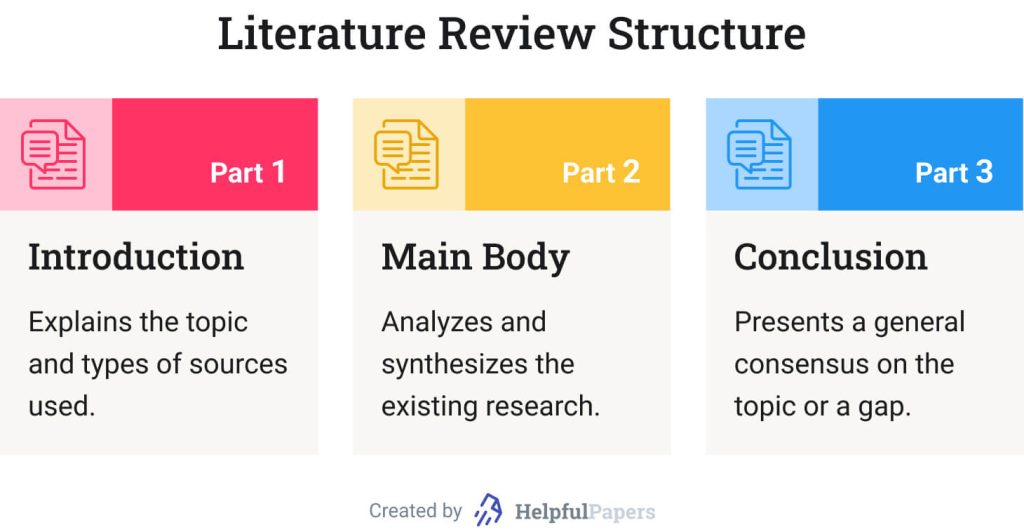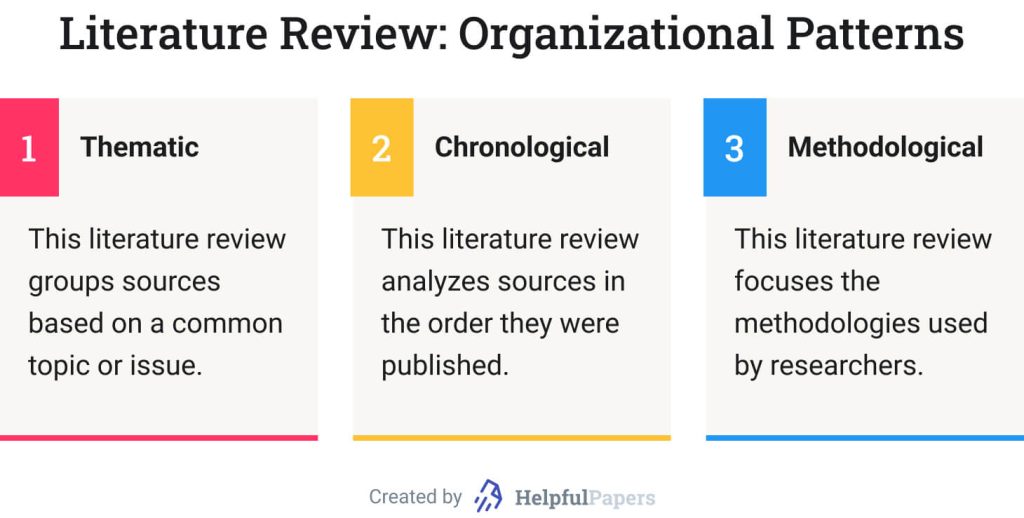
A review of related literature is a separate paper or a part of an article that collects and synthesizes discussion on a topic. Its purpose is to show the current state of research on the issue and highlight gaps in existing knowledge. A literature review can be included in a research paper or scholarly article, typically following the introduction and before the research methods section.

This article will clarify the definition, significance, and structure of a review of related literature. You’ll also learn how to organize your literature review and discover ideas for an RRL in different subjects.
Table of ContentsA review of related literature (RRL) is a part of the research report that examines significant studies, theories, and concepts published in scholarly sources on a particular topic. An RRL includes 3 main components:
Although the goal of a review of related literature differs depending on the discipline and its intended use, its significance cannot be overstated. Here are some examples of how a review might be beneficial:
Including a description of your search strategy in the literature review section can significantly increase your grade. You can search sources with the following steps:

An introduction should clarify the study topic and the depth of the information to be delivered. It should also explain the types of sources used. If your lit. review is part of a larger research proposal or project, you can combine its introductory paragraph with the introduction of your paper.
Here is a sample introduction to an RRL about cyberbullying:
Bullying has troubled people since the beginning of time. However, with modern technological advancements, especially social media, bullying has evolved into cyberbullying. As a result, nowadays, teenagers and adults cannot flee their bullies, which makes them feel lonely and helpless. This literature review will examine recent studies on cyberbullying.
A thesis statement should include the central idea of your literature review and the primary supporting elements you discovered in the literature. Thesis statements are typically put at the end of the introductory paragraph.
Look at a sample thesis of a review of related literature:
This literature review shows that scholars have recently covered the issues of bullies’ motivation, the impact of bullying on victims and aggressors, common cyberbullying techniques, and victims’ coping strategies. However, there is still no agreement on the best practices to address cyberbullying.
The main body of a literature review should provide an overview of the existing research on the issue. Body paragraphs should not just summarize each source but analyze them. You can organize your paragraphs with these 3 elements:
Here’s a literature review body paragraph example:
Scholars have examined the link between the aggressor and the victim. Beran et al. (2007) state that students bullied online often become cyberbullies themselves. Faucher et al. (2014) confirm this with their findings: they discovered that male and female students began engaging in cyberbullying after being subject to bullying. Hence, one can conclude that being a victim of bullying increases one’s likelihood of becoming a cyberbully.
A conclusion presents a general consensus on the topic. Depending on your literature review purpose, it might include the following:
Check out a conclusion example that discusses a research gap:
There is extensive research into bullies’ motivation, the consequences of bullying for victims and aggressors, strategies for bullying, and coping with it. Yet, scholars still have not reached a consensus on what to consider the best practices to combat cyberbullying. This question is of great importance because of the significant adverse effects of cyberbullying on victims and bullies.
In this section, we will discuss how to format an RRL according to the most common citation styles: APA, Chicago, MLA, and Harvard.
Writing a literature review using the APA7 style requires the following text formatting:

A thematic literature review is arranged around central themes or issues discussed in the sources. If you have identified some recurring themes in the literature, you can divide your RRL into sections that address various aspects of the topic. For example, if you examine studies on e-learning, you can distinguish such themes as the cost-effectiveness of online learning, the technologies used, and its effectiveness compared to traditional education.
A chronological literature review is a way to track the development of the topic over time. If you use this method, avoid merely listing and summarizing sources in chronological order. Instead, try to analyze the trends, turning moments, and critical debates that have shaped the field’s path. Also, you can give your interpretation of how and why specific advances occurred.
A methodological literature review differs from the preceding ones in that it usually doesn’t focus on the sources’ content. Instead, it is concerned with the research methods. So, if your references come from several disciplines or fields employing various research techniques, you can compare the findings and conclusions of different methodologies, for instance:
We have prepared a short example of RRL on climate change for you to see how everything works in practice!
Climate change is one of the most important issues nowadays. Based on a variety of facts, it is now clearer than ever that humans are altering the Earth's climate. The atmosphere and oceans have warmed, causing sea level rise, a significant loss of Arctic ice, and other climate-related changes. This literature review provides a thorough summary of research on climate change, focusing on climate change fingerprints and evidence of human influence on the Earth's climate system.
Physical Mechanisms and Evidence of Human Influence
Scientists are convinced that climate change is directly influenced by the emission of greenhouse gases. They have carefully analyzed various climate data and evidence, concluding that the majority of the observed global warming over the past 50 years cannot be explained by natural factors alone. Instead, there is compelling evidence pointing to a significant contribution of human activities, primarily the emission of greenhouse gases (Walker, 2014). For example, based on simple physics calculations, doubled carbon dioxide concentration in the atmosphere can lead to a global temperature increase of approximately 1 degree Celsius. (Elderfield, 2022). In order to determine the human influence on climate, scientists still have to analyze a lot of natural changes that affect temperature, precipitation, and other components of climate on timeframes ranging from days to decades and beyond.
Fingerprinting Climate Change
Fingerprinting climate change is a useful tool to identify the causes of global warming because different factors leave unique marks on climate records. This is evident when scientists look beyond overall temperature changes and examine how warming is distributed geographically and over time (Watson, 2022). By investigating these climate patterns, scientists can obtain a more complex understanding of the connections between natural climate variability and climate variability caused by human activity.
Modeling Climate Change and Feedback
To accurately predict the consequences of feedback mechanisms, the rate of warming, and regional climate change, scientists can employ sophisticated mathematical models of the atmosphere, ocean, land, and ice (the cryosphere). These models are grounded in well-established physical laws and incorporate the latest scientific understanding of climate-related processes (Shuckburgh, 2013). Although different climate models produce slightly varying projections for future warming, they all will agree that feedback mechanisms play a significant role in amplifying the initial warming caused by greenhouse gas emissions. (Meehl, 2019).
In conclusion, the literature on global warming indicates that there are well-understood physical processes that link variations in greenhouse gas concentrations to climate change. In addition, it covers the scientific proof that the rates of these gases in the atmosphere have increased and continue to rise fast. According to the sources, the majority of this recent change is almost definitely caused by greenhouse gas emissions produced by human activities. Citizens and governments can alter their energy production methods and consumption patterns to reduce greenhouse gas emissions and, thus, the magnitude of climate change. By acting now, society can prevent the worst consequences of climate change and build a more resilient and sustainable future for generations to come.
Have you ever struggled with finding the topic for an RRL in different subjects? Read the following paragraphs to get some ideas!
Many topics in the nursing field require research. For example, you can write a review of literature related to dengue fever. Give a general overview of dengue virus infections, including its clinical symptoms, diagnosis, prevention, and therapy.
Another good idea is to review related literature and studies about teenage pregnancy. This review can describe the effectiveness of specific programs for adolescent mothers and their children and summarize recommendations for preventing early pregnancy.
📝 Check out some more valuable examples below:
If you look for an RRL topic in psychology, you can write a review of related literature about stress. Summarize scientific evidence about stress stages, side effects, types, or reduction strategies. Or you can write a review of related literature about computer game addiction. In this case, you may concentrate on the neural mechanisms underlying the internet gaming disorder, compare it to other addictions, or evaluate treatment strategies.
A review of related literature about cyberbullying is another interesting option. You can highlight the impact of cyberbullying on undergraduate students’ academic, social, and emotional development.
📝 Look at the examples that we have prepared for you to come up with some more ideas:
Sociological research poses critical questions about social structures and phenomena. For example, you can write a review of related literature about child labor, exploring cultural beliefs and social norms that normalize the exploitation of children. Or you can create a review of related literature about social media. It can investigate the impact of social media on relationships between adolescents or the role of social networks on immigrants’ acculturation.
📝 You can find some more ideas below!
For your education studies, you can write a review of related literature about academic performance to determine factors that affect student achievement and highlight research gaps. One more idea is to create a review of related literature on study habits, considering their role in the student’s life and academic outcomes.
You can also evaluate a computerized grading system in a review of related literature to single out its advantages and barriers to implementation. Or you can complete a review of related literature on instructional materials to identify their most common types and effects on student achievement.
📝 Find some inspiration in the examples below:
If you’re a business student, you can focus on customer satisfaction in your review of related literature. Discuss specific customer satisfaction features and how it is affected by service quality and prices. You can also create a theoretical literature review about consumer buying behavior to evaluate theories that have significantly contributed to understanding how consumers make purchasing decisions.
📝 Look at the examples to get more exciting ideas:
To conclude, a review of related literature is a significant genre of scholarly works that can be applied in various disciplines and for multiple goals. The sources examined in an RRL provide theoretical frameworks for future studies and help create original research questions and hypotheses.
When you finish your outstanding literature review, don’t forget to check whether it sounds logical and coherent. Our text-to-speech tool can help you with that!